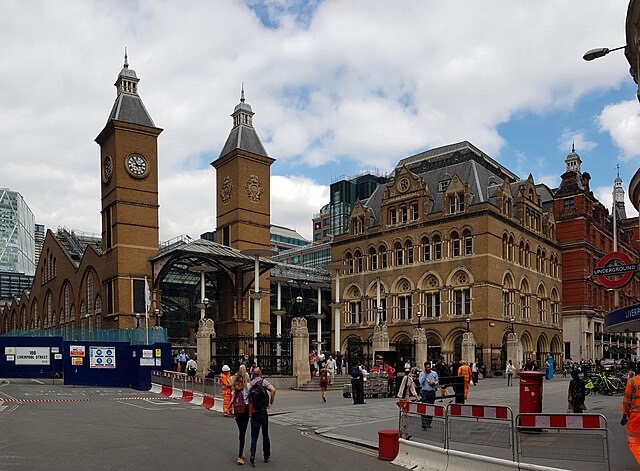What Triggered the Emergency Evacuation
On April 17, 2025, chaos erupted at Liverpool’s iconic Lime Street Station when plumes of smoke started billowing through the concourse. Panic quickly spread as alarms blared and station officials, along with firefighters, evacuated the premises. Eyewitnesses reported a burning smell moments before thick black smoke flooded parts of the station, causing confusion and fear among travelers and retail staff.
The source of the smoke remains under investigation, but early speculation pointed to a possible electrical fire in the station’s infrastructure or utility area. Whatever the cause, the impact was immediate and severe—thousands of passengers were evacuated, trains came to a halt, and surrounding businesses were forced to shut down.
Transport for Liverpool swiftly suspended all incoming and outgoing services at Lime Street, one of the busiest railway stations in Northern England. Local news outlets like ITV and People provided real-time updates, confirming that this incident echoed previous station fire emergencies in both the UK and the U.S.
Official Timeline of the Event
The following timeline captures the key moments of the emergency response at Liverpool Lime Street Station:
- 1:15 PM BST – Smoke is first seen rising near platform infrastructure.
- 1:20 PM – Station alarms are triggered; staff initiate immediate evacuation.
- 1:25 PM – Firefighters from Merseyside Fire & Rescue arrive on site.
- 1:30 PM – Surrounding businesses are ordered to evacuate as a safety precaution.
- 1:45 PM – All train services at Liverpool Lime Street are suspended.
- 2:00 PM – Fire crews begin isolating potential sources of the smoke.
- 2:30 PM – No injuries are reported; fire crews confirm fire is under control.
- 4:00 PM – Emergency response continues; train delays and cancellations announced.
This event showcased the importance of emergency readiness, especially in public transit zones with dense foot traffic and structural complexity. Evacuating a facility of this size—connected to multiple platforms, retail stores, underground tunnels, and city bus links—was no small feat.
Emergency Response by Firefighters
How Merseyside Fire and Rescue Contained the Situation
Merseyside Fire & Rescue deployed a full response unit, including breathing apparatus crews, thermal imaging gear, and structural engineers. Within minutes, teams were entering the smoky areas, locating the source, and checking for trapped individuals. Fortunately, their swift response ensured no injuries occurred.
Chief Fire Officer Michael Roper stated: “We commend the bravery and professionalism of our crews who navigated intense smoke conditions to ensure public safety. The situation could have escalated significantly without this immediate and coordinated action.”
Firefighters used specialized ventilation fans to disperse smoke and prevent re-ignition while paramedics stood by in case any commuters experienced breathing difficulties or panic attacks. While the fire was small in scale, its impact was magnified due to the station’s central location and time of day.
Equipment Used and Evacuation Strategy
To combat the smoke and secure the station, responders utilized:
- High-pressure hose reels
- Portable lighting for visibility
- Thermal imaging cameras to detect hotspots
- Oxygen masks and respirators for entering contaminated areas
The evacuation was guided by a pre-established fire drill protocol, with stewards ushering passengers through emergency exits and designated safe zones. Station staff had been trained for such emergencies, and it showed. Despite the initial panic, the crowds moved efficiently, and within 15 minutes, the station was cleared of all personnel.
The event also highlighted the role of Liverpool’s integrated emergency response systems. Police managed traffic and access to the scene while fire and medical personnel coordinated from a central command point just outside the station’s main exit.
Passenger Safety and Crowd Control
Evacuation of Liverpool Lime Street Station
Liverpool Lime Street sees tens of thousands of passengers each day, making an evacuation especially complex. Authorities had to deal with not just passengers on platforms, but also those in food courts, shopping arcades, ticket halls, and connecting buses.
Crowds flowed into nearby streets as loudspeakers instructed people to remain calm and follow safety routes. Additional support came from British Transport Police, who formed cordons and helped control foot traffic to prevent stampedes or dangerous crowd crushes.
Despite the thick smoke, no injuries were reported—a testament to how well the safety systems worked. It’s worth noting that emergency responders were also quick to establish a perimeter around the station to keep non-essential personnel and curious bystanders at bay.
Crowd Management and Panic Prevention
Managing the emotional response of large groups is never easy, especially in emergencies. The station’s public address system played a critical role in relaying calm, concise instructions. Bilingual announcements helped international travelers who were unfamiliar with UK protocols.
Volunteers from local aid organizations and railway staff handed out water and masks to passengers who had been standing in smoke-filled areas. Temporary shelter areas were set up in nearby halls for those with mobility issues or urgent travel needs.
Transportation updates were sent via text alert systems and official Twitter accounts, with hashtags like #LiverpoolStationFire and #LimeStreetEvacuation trending for hours. This widespread digital coverage helped prevent misinformation and coordinated alternative travel routes.



